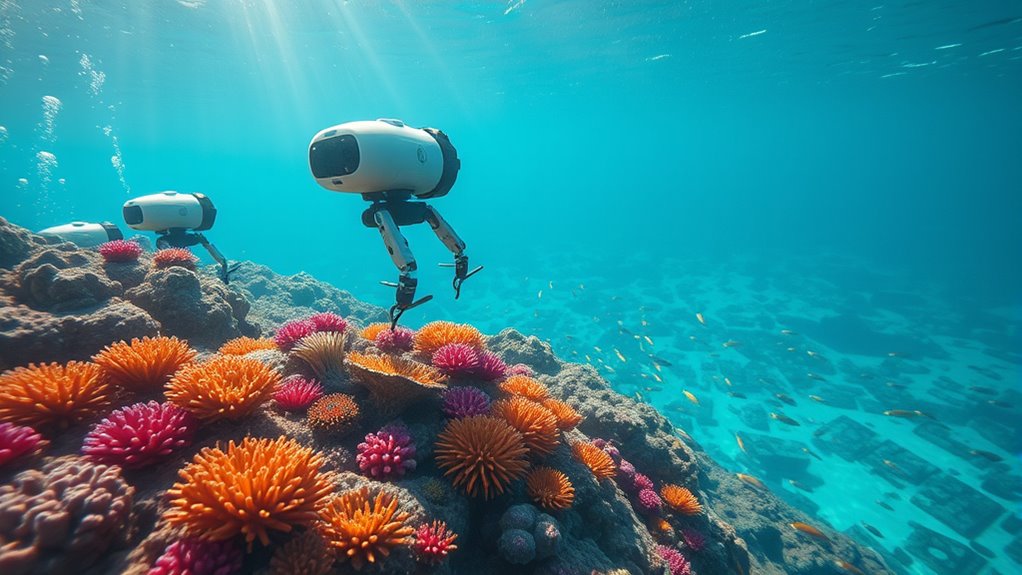Coral-growing robots are revolutionizing reef restoration by accelerating recovery timelines, often by about 10 years. They operate underwater with high precision, planting coral fragments, monitoring growth, and cleaning habitats efficiently. Their autonomous capabilities and specialized tools help re-establish healthy reefs faster, reducing the decades traditionally needed. These robots also protect fragile environments with gentle handling and advanced navigation. If you want to discover how they’re transforming marine conservation even further, keep exploring this innovative technology.
Key Takeaways
- Coral-growing robots enable rapid reef restoration by automating planting, monitoring, and cleaning tasks, reducing recovery time significantly.
- Their autonomous operations cover larger areas efficiently, accelerating ecosystem recovery by reaching milestones decades faster.
- Precision tools prevent damage to fragile habitats, ensuring faster, safer coral growth and ecosystem stabilization.
- Use of renewable energy sources enhances sustainability, allowing continuous, large-scale restoration efforts without environmental harm.
- Data collection and targeted interventions improve restoration success rates, leading to quicker biodiversity recovery within a decade.

Coral-growing robots are transforming efforts to restore damaged marine ecosystems by actively cultivating and nurturing coral reefs. These innovative machines are designed to operate efficiently underwater, targeting areas where coral health has declined due to climate change, pollution, or overfishing. By doing so, they play a crucial role in boosting marine biodiversity, which is essential for maintaining balanced and resilient ecosystems. The design of these robots focuses on versatility, durability, and precision, enabling them to perform complex tasks in challenging underwater environments. Their compact form allows them to navigate tight spaces and delicate reef structures without causing further damage, guaranteeing the restoration process is both effective and sustainable.
Coral-growing robots actively restore marine ecosystems with precise, durable, and efficient underwater cultivation.
The robot design is fundamental to their success. Engineers have developed these machines with specialized tools that can plant coral fragments, monitor growth, and even clean algae or sediment buildup that hinder coral health. Many feature articulated arms and modular attachments that can adapt to different tasks, making them highly efficient in various reef conditions. They are equipped with sensors and cameras that provide real-time data, allowing operators to track coral development and identify problems early. This data-driven approach guarantees that interventions are targeted and timely, greatly improving the chances of successful reef recovery.
You’ll find that these robots are also engineered for longevity and energy efficiency. They often run on renewable power sources, such as solar or underwater turbines, reducing their environmental footprint. Their ability to operate autonomously or semi-autonomously means they can cover large reef areas quickly, something that manual restoration efforts often struggle to achieve. This increased efficiency accelerates reef recovery, often reaching milestones that would normally take decades in just a few years. By doing so, the robots help restore marine biodiversity at a much faster rate, supporting the proliferation of fish, invertebrates, and other marine life that depend on healthy coral ecosystems.
Furthermore, the robot design incorporates safety features to protect the fragile reef environment. Soft-touch tools and gentle maneuvering prevent accidental damage, and advanced navigation systems help avoid collisions with existing coral structures. Because of these thoughtful design elements, the robots can work in delicate habitats without compromising their integrity. Their ability to perform precise, repetitive tasks consistently enhances the overall health of the reef, making the restoration process more predictable and scalable.
Frequently Asked Questions
How Do Coral-Growing Robots Impact Local Marine Ecosystems?
You might wonder how coral-growing robots impact local marine ecosystems. These robots promote marine biodiversity by helping restore damaged reefs, providing habitats for various marine species. As a result, they strengthen ecosystem resilience, making ecosystems more resistant to climate change and human threats. By accelerating reef recovery, they support healthier, more diverse marine environments, benefiting both marine life and local communities reliant on sustainable fisheries and tourism.
What Are the Long-Term Environmental Risks of Deploying These Robots?
You might not realize it, but long-term risks of deploying coral-growing robots include biodegradation concerns, where robot materials could break down and harm marine life. Additionally, robotic pollution from discarded or malfunctioning units could disrupt ecosystems. Although these robots boost reef recovery, you should consider potential impacts like invasive material buildup and unintentional habitat damage, which might persist for decades and challenge marine conservation efforts.
How Cost-Effective Are Coral-Growing Robots Compared to Traditional Methods?
You should consider that coral-growing robots offer significant cost analysis advantages over traditional methods. They’re more efficient, reducing labor and time, which boosts economic benefits in reef restoration projects. While initial investments might be higher, the long-term savings from faster recovery and less resource use make these robots highly cost-effective. Overall, deploying them can lead to sustainable, economically sound solutions for restoring coral reefs efficiently.
Can These Robots Operate in Deep or Extreme Ocean Conditions?
Think of these robots as underwater explorers tackling deep sea challenges like a submarine steering treacherous waters. While they’re designed for various conditions, operating in extreme conditions or deep ocean environments pushes their limits. They require specialized equipment to withstand high pressure, low temperatures, and darkness. Currently, most are optimized for shallow reefs, but ongoing advancements aim to make them capable of handling the harsh realities of deep sea challenges.
What Are the Future Technological Advancements Planned for Coral-Growing Robots?
You’ll see future coral-growing robots become more advanced with autonomous navigation and AI integration. These innovations will enable them to operate more efficiently in complex reef environments, adapt to changing conditions, and target specific areas needing restoration. As technology progresses, expect robots to self-navigate with minimal human input, precisely plant coral, and optimize reef recovery efforts, ultimately making restoration faster, more effective, and sustainable.
Conclusion
You can’t afford to ignore how these coral-growing robots are revolutionizing reef recovery; they might just be the most groundbreaking innovation in marine conservation ever. With their incredible speed—accelerating reef healing by a decade—they’re turning back the clock on environmental damage faster than you’d believe possible. Imagine a future where coral reefs thrive again, vibrant and unstoppable, all thanks to these tiny underwater heroes. The ocean’s destiny is changing, and you’re witnessing the dawn of a new, resilient era.










